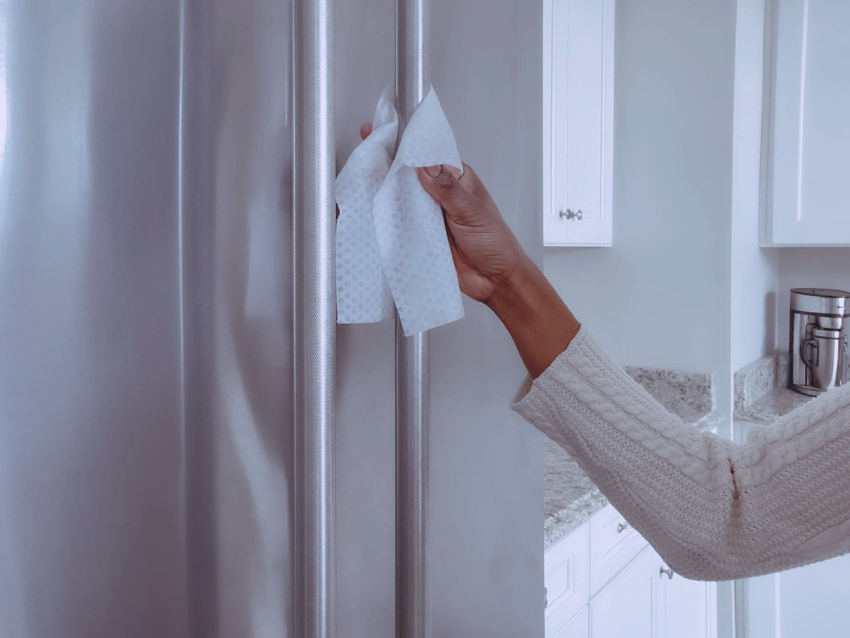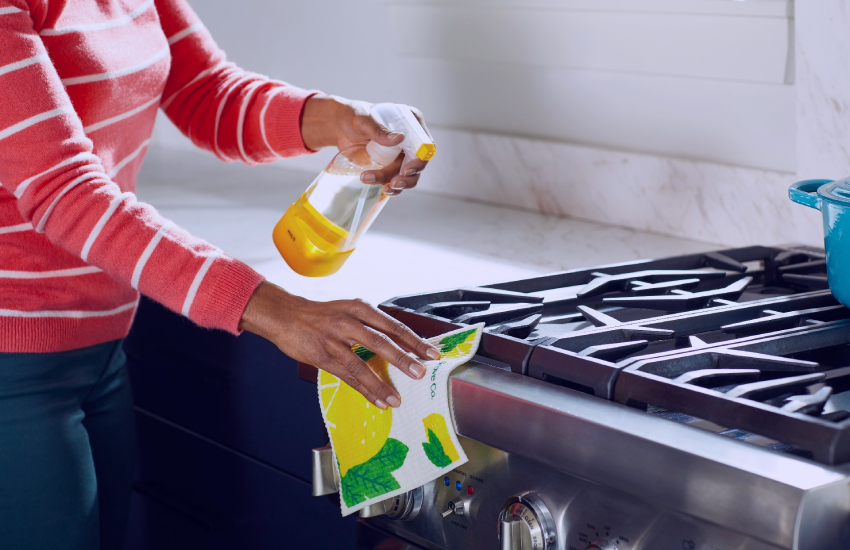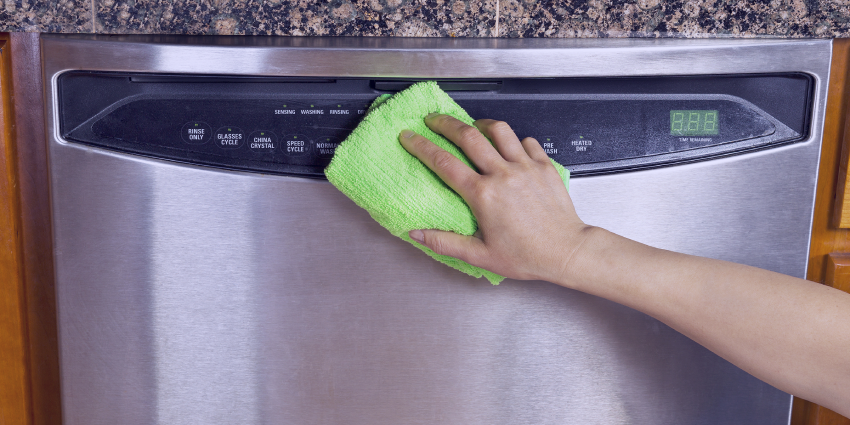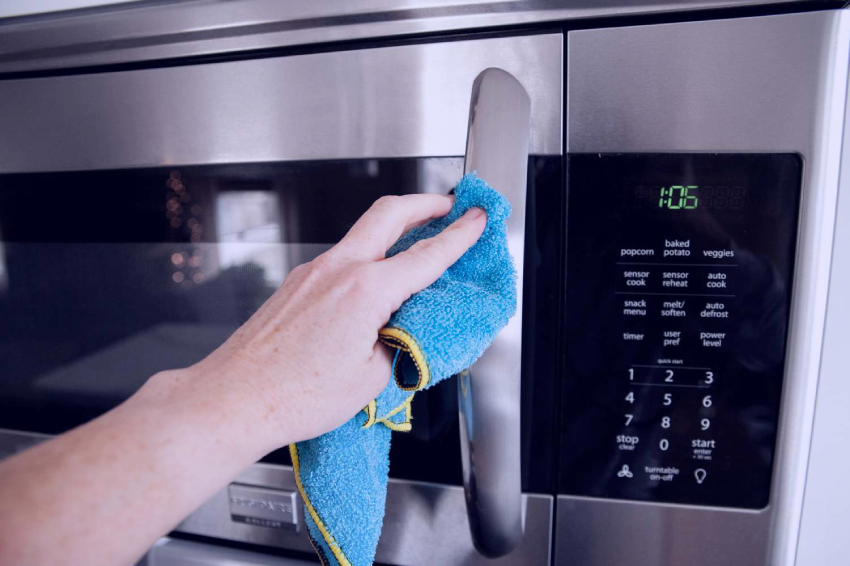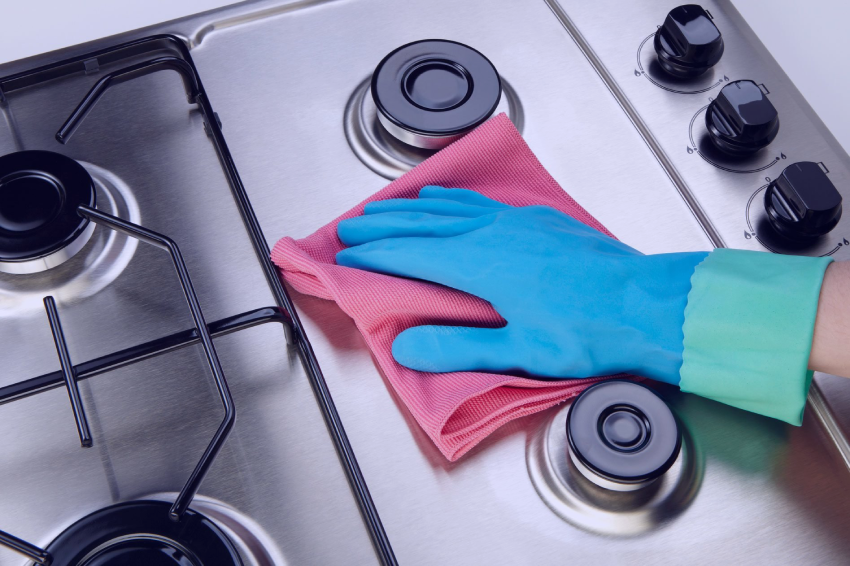Learn to maintain the shine and prevent scratches with our guide on how to clean stainless steel appliances like a pro.
Stainless steel appliances can add a stylish touch to your home, with their pristine shine and modern look. After a few months, even stainless steel can start to lose its shine and smudge-free appearance. We’ve uncovered the tried and true methods to clean your appliances that will make them sparkle again. Here’s everything you need to know about how to properly clean stainless steel appliances and remove those pesky streaks for good.
Choosing the Right Cleaning Products
Fortunately, there are plenty of cleaners that are formulated specifically to clean stainless steel. Some well-regarded brands include Weiman, Therapy, and Magic Stainless Steel Cleaner.
Your appliance manual can be a hidden gem when choosing your cleaning product. Manufacturers often suggest certain types or specific brands that work best with your appliance to help you avoid unnecessary damage and maintain the appliance’s integrity.
Understanding Stainless Steel Cleaner Types
Stainless steel cleaners typically come in two forms: creams and sprays. While both are effective, your preference might depend on the type and extent of the grime you’re dealing with.
- Creamy Cleaners: More suited for deep cleaning and stubborn stains – their thick consistency allows them to stay longer on the surface giving it more time to break the grime down.
- Spray Cleaners: Ideal for light cleaning and quick touch-ups. They leave less residue and are easier to use for everyday cleaning.
Avoiding Harsh Chemicals
Bleach, although a powerful disinfectant, is not suited for stainless steel. It tends to corrode and discolor the surface, leaving behind a layer of rust that damages its glossy finish.
Harsh chemicals like acids, alkalis, or chloride-based solutions can damage your stainless steel appliances. They erode the protective layer, making it susceptible to surface damage and discoloration.
Given the potential damage, it’s better to be safe than sorry and opt for safer alternatives to protect your appliances.
Safe Cleaning Solutions
For those looking for a natural and non-abrasive approach to stainless steel cleaning, vinegar and oil present a valuable solution. This combination can both clean and polish your stainless steel appliances, leaving them looking brand new.
You can also try using a mixture of baking soda and a little water to make a non-abrasive paste that can tackle stubborn stains.
Preparing Your Appliances for Cleaning
Before you embark on your cleaning journey, don’t forget to unplug your appliances – this not only ensures your safety but can also prevent possible damage to your devices. By preparing your appliances for cleaning, you’ll have a much smoother experience giving your appliances that much-needed refresh.
Removing Loose Dirt and Debris
For a thorough cleansing cycle for your stainless steel appliances, tackle the loose dirt and debris first. A simple wipe-down using a microfiber cloth does the job. However, prepare to use a little extra grease for stubborn spots.
Protecting Surrounding Areas
For a mess-free cleaning process, remember to cover adjacent surfaces. This simple act of placing sheets, old newspapers, or plastic wrap can spare your kitchen decor from unwanted splashes of water, cleaner, or polish.
While cleaning stainless steel appliances, it’s important to protect any wooden parts from water stains. A simple trick is to apply painter’s tape on the wooden sections before starting. This helps avoid unsightly water stains on wood while getting your stainless steel appliances squeaky clean.
Cleaning Techniques for Stainless Steel
Adopting certain practices will ensure the longevity of your stainless steel’s shine. One key method is to use a microfiber cloth to apply your cleaner—this material won’t scratch the surface. Also, be sure to always rinse the cleaner off thoroughly and dry the appliance immediately to avoid water spots or streaking.
Using Microfiber Cloth
A microfiber cloth is an unsung hero in maintaining the shine of your stainless steel appliances. Its ultra-soft, non-abrasive fabric effectively lifts and traps dust and grime without scratching or dulling the finish.
- Microfiber Magic: The tiny fibers in a microfiber cloth create a large surface area that attracts dust and dirt, making it more effective at cleaning than traditional cloths.
- Gentleness Matters: Unlike rougher materials, microfiber won’t scratch your stainless steel appliances, preserving their pristine shine.
- Easy to Clean: Microfiber cloths can be machine washed, making them a reusable and eco-friendly cleaning option.
- Versatility: Suitable for other surfaces too, microfiber cloths can be used to clean including glass, wood, and more.
Applying the Cleaner
When applying your chosen cleaner to your stainless steel appliance, you want to ensure an optimal cleaning experience. A common question is whether to start from the bottom and work your way up, or vice versa.
- The recommended sequence for cleaner application is from top to bottom. This prevents the cleaner from dripping down onto already cleaned areas.
- Avoid a rushed cleaning job. To achieve a streak-free stainless steel surface, patience is key. Let your cleaner sit and work its magic for a few minutes before you wipe it off.
Wiping in the Right Direction
When it comes to the correct way of wiping, always pay attention to the grain of your stainless steel. The polish lines on your appliance have a direction—that’s the grain. Cleaning along instead of against this grain won’t dull the shine and will help you avoid unwanted scratches from trapped particles of dust and dirt.
Polishing and Buffing
For the final step, give your stainless steel appliances a brilliant mirror shine. Apply a stainless steel polish in small amounts onto a soft, clean cloth.
Now it’s buffing time! Buffing not only helps to enhance the shine but also assists in hiding minor scratches. While buffing, remember to avoid circular movements and stay with the grain instead.
Giving some extra attention to the edges and handles of your appliances will make a notable difference. While polishing and buffing, pay special care to these areas. Consistent care will maintain your stainless steel’s lustrous appearance for years to come.
Maintaining the Shine
Who says you need a professional to keep your appliances shiny? With consistent, day-to-day maintenance, you can keep your stainless steel appliances looking like new. By keeping up with your daily cleaning routine, you’ll be able to maintain a glossy shine on your stainless steel appliances.
Regular Dusting and Wiping
Regular dusting prevents grime buildup and keeps appliances in top condition. It’s an easy, no-fuss routine that preserves longevity while delivering impressive shine.
Wipe your appliances each evening before bed or right after cooking. This small act can make an astounding difference, keeping surfaces clean and preventing damage.
Preventing Water Spots
To win the battle against water spots, always dry your appliances after cleaning. Pay extra attention to areas where water is frequently used, like near the dishwasher or sink.
Avoid distortions on your shiny surfaces by not leaving wet items on them. Use coasters, mats, or trays under plant pots or wet containers. This can significantly minimize the dreaded water spots on your cherished appliances.
Troubleshooting and Stain Removal
Stains on stainless steel can look unappealing, but don’t fret! They are mostly surface-level and can be easily resolved. Scratches or discoloration can also be especially frustrating. Fortunately, specific stainless steel cleaners or polishers can help blend these marks. To keep stains and scratches at bay, follow these tips to keep your stainless steel appliances in pristine condition.
Removing Stubborn Stains
For stubborn stains, patience is a virtue. Apply your chosen stainless steel cleaner and let it sit for a few minutes. This gives the cleaner time to penetrate the stain, making it easier to wipe away.
Remember, intense scrubbing could scratch the surface. If you’re dealing with a highly resistant stain, consider employing the services of a professional cleaner to prevent damage.
Dealing with Scratches
When you stumble upon scratches on your stainless steel appliances, don’t despair. You can make these eyesores disappear!
First, wipe away any dust or debris. Then, with a stainless-steel cleaner or baking soda paste applied to a microfiber cloth, buff the area. Patience and consistency are key here. With these simple tips, scratches will be less prominent, restoring your appliances’ sleek appearance.
Fixing Surface Discoloration
Unwanted tints of rainbow can be a pain on stainless steel, but they’re quite easy to tackle. These multicolored stains are often heat stains, so cooling them off and applying a special stainless steel cleaner can lead to a shiny and uniform surface.
Cloudiness can dampen the shimmer of your appliances. To erase this hazy layer, gently rub it with a solution of vinegar and water. Wipe dry immediately to prevent new spots, and voila – your stainless steel appliance is back to its glossy glory.
Frequently Asked Questions
Q: Can I use olive oil to polish stainless steel appliances?
A: Yes, olive oil can be used to polish stainless steel appliances and give them a shiny finish. Apply a small amount of olive oil to a soft cloth and gently rub it onto the surface of the appliance. Make sure to wipe off any excess oil to avoid leaving a greasy residue.
Q: Can I use a dishwasher to clean stainless steel appliances?
A: While stainless steel appliances are generally resistant to water and moisture, it is not recommended to clean them in a dishwasher. The high heat and harsh detergents used in dishwashers can potentially damage the stainless steel surface. It’s best to stick to manual cleaning methods for stainless steel appliances.
Q: Can I use glass cleaner on stainless steel appliances?
A: It is not recommended to use glass cleaner on stainless steel appliances, as they may contain chemicals that can damage the surface. Stick to using mild soapy water or specialized stainless steel cleaners for best results.
Q: Can I use lemon juice to clean stainless steel appliances?
A: Lemon juice can be used as a natural cleaner for stainless steel appliances. Mix equal parts of lemon juice and water, and use a soft cloth to wipe down the surface. The acidic properties of lemon juice can help remove stains and bring back the shine.
